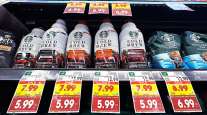Associated Press
Inflation Gauge Shows Price Pressures Easing Gradually

[Stay on top of transportation news: Get TTNews in your inbox.]
WASHINGTON — A measure of inflation that is closely tracked by the Federal Reserve slipped last month in a sign that price pressures continue to ease.
The government reported March 29 that prices rose 0.3% from January to February, decelerating from a 0.4% increase the previous month in a potentially encouraging trend for President Joe Biden’s re-election bid.
Compared with 12 months earlier, though, prices rose 2.5% in February, up slightly from a 2.4% year-over-year gain in January.
Excluding volatile food and energy costs, so-called core prices rose 0.3% from January to February, down from 0.5% in the previous month. Core prices rose 2.8% from a year earlier last month, down from a revised 2.9% in January. Economists consider core prices to be a better gauge of the likely path of future inflation.
Greg Hewitt of DHL Express considers whether the trucking industry is prepared for a greener future. Tune in above or by going to RoadSigns.ttnews.com.
Annual inflation, as measured by the Fed’s preferred gauge, tumbled in 2023 after having peaked at 7.1% in mid-2022. Supply chain bottlenecks eased, reducing the costs of materials, and an influx of job seekers made it easier for employers to keep a lid on wage growth, one of the drivers of inflation.
Still, inflation remains stubbornly above the Fed’s 2% annual target, and opinion surveys have revealed public discontent that high prices are squeezing America’s households despite a sharp pickup in average wages.
The acceleration of inflation began in the spring of 2021 as the economy roared back from the pandemic recession, overwhelming factories, ports and freight yards with orders. In March 2022, the Fed began raising its benchmark interest rate to try to slow borrowing and spending and cool inflation, eventually boosting its rate 11 times to a 23-year high. Those sharply higher rates worked as expected in helping tame inflation.
The jump in borrowing costs for companies and households was also expected, though, to cause widespread layoffs and tip the economy into a recession. That didn’t happen. The economy has grown at a healthy annual rate of 2% or more for six straight quarters. Job growth has been solid. And the unemployment rate has remained below 4% for 25 straight months, the longest such streak since the 1960s.
The combination of easing inflation and sturdy growth and hiring has raised expectations that the Fed will achieve a difficult “soft landing” — taming inflation without causing a recession. If inflation continues to ease, the Fed will likely begin cutting its key rate in the coming months. Rate cuts would, over time, lead to lower costs for home and auto loans, credit card borrowing and business loans. They might also aid Biden’s re-election prospects.
Want more news? Listen to today's daily briefing above or go here for more info
The Fed tends to favor the inflation gauge that the government issued March 29 — the personal consumption expenditures price index — over the better-known consumer price index. The PCE index tries to account for changes in how people shop when inflation jumps. It can capture, for example, when consumers switch from pricier national brands to cheaper store brands.
In general, the PCE index tends to show a lower inflation level than CPI. In part, that’s because rents, which have been high, carry double the weight in the CPI that they do in the PCE.





